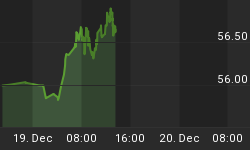
With Friday's triple witching, we're entering into the last couple of sessions of the running year, and the S&P 500 is already up +5.26% month-to-date, and up +11.46% year-to-date (on close of Thursday, December 16).
An interesting question is if the recent run-up in the markets or the fact that the S&P 500 is up year-to-date proves to be advantageous or disadvantageous for a continuation of the recent run-up until the end of the year. I therefore checked for the S&P 500′s year-end performance assumed one went long on close of December's triple witching Friday (or the 3rd Friday in December before 1974) - in this event on Friday, December 18 - and went into cash again on close of the last session of the year.
Table I below shows the date of the last session of the month ('End-of-Month Day'), the S&P 500′s historical (since 1930) performance ('Monthly Returns') between December's triple witching Friday (or the 3rd Friday in December before 1974) and the last session of the year, the respective number of sessions, the maximum gain and the maximum loss (drawdown) during the period under review in the past.

(* no close below trigger day's close during period under review)
It is interesting to note that
- ... the S&P 500 closed at a higher level on the last session of the year on 40 out of 52 occurrences (or 76.92% of the time) ;
- ... the S&P 500 lost more than -1.0% on only 6, but gained at least +1.0% on 26 out of those 52 occurrences ; and
- ... the S&P 500 posted a median gain of +0.97% during the period under review (regularly 6 to 11 sessions).
But what happened over the course of the remainder of the year of the year if the S&P 500 not only was up year-to-date 10.00% or more, but up month-to-date and week-to-date as well (at time of writing the S&P 500 is up +0.13% on the running week), an extremely positive scenario (at least up to December's triple witching Friday on the then running year).
Table II below shows the date of the last session of the month ('End-of-Month Day'), the S&P 500′s historical (since 1930) performance ('Monthly Returns') between December's triple witching Friday (or the 3rd Friday in December before 1974) and the last session of the year, the respective number of sessions, the maximum gain and the maximum loss (drawdown) during the period under review in the past.

(* no close below trigger day's close during period under review)
Although the number of occurrences is limited, it is at least interesting to note that
- ... the S&P 500 closed at a higher level on the last session of the year on 15 out of 17 occurrences (or 88.25% of the time) ; and
- ... the S&P 500 posted a median gain of +1.11% during the period under review (regularly 6 to 11 sessions).
Conclusions:
I don't want to sound like a broken record, but from a statistical and historical point of view, this might still (despite any 'overbought' indications or indicators) not be the peak time to bet the farm on any short-term mean reversion tendency until the end of the year. Historically a positive year-to-date, month-to-date and week-to-date performance was advantageous for the S&P 500′s performance between December's triple witching Friday (or the 3rd Friday in December before 1974) and the last session of the year (subject to any force majeure).
Successful trading,















